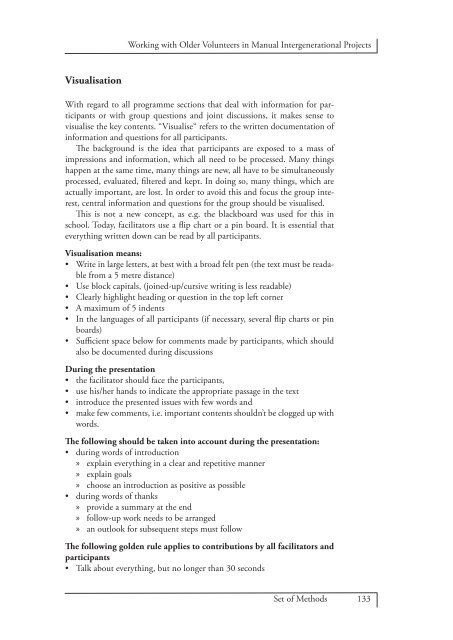Download - TRAMP - Arbeit und Leben DGB/VHS
Download - TRAMP - Arbeit und Leben DGB/VHS
Download - TRAMP - Arbeit und Leben DGB/VHS
You also want an ePaper? Increase the reach of your titles
YUMPU automatically turns print PDFs into web optimized ePapers that Google loves.
Visualisation<br />
Working with Older Volunteers in Manual Intergenerational Projects<br />
With regard to all programme sections that deal with information for participants<br />
or with group questions and joint discussions, it makes sense to<br />
visualise the key contents. “Visualise“ refers to the written documentation of<br />
information and questions for all participants.<br />
The backgro<strong>und</strong> is the idea that participants are exposed to a mass of<br />
impressions and information, which all need to be processed. Many things<br />
happen at the same time, many things are new, all have to be simultaneously<br />
processed, evaluated, filtered and kept. In doing so, many things, which are<br />
actually important, are lost. In order to avoid this and focus the group interest,<br />
central information and questions for the group should be visualised.<br />
This is not a new concept, as e.g. the blackboard was used for this in<br />
school. Today, facilitators use a flip chart or a pin board. It is essential that<br />
everything written down can be read by all participants.<br />
Visualisation means:<br />
• Write in large letters, at best with a broad felt pen (the text must be readable<br />
from a 5 metre distance)<br />
• Use block capitals, (joined-up/cursive writing is less readable)<br />
• Clearly highlight heading or question in the top left corner<br />
• A maximum of 5 indents<br />
• In the languages of all participants (if necessary, several flip charts or pin<br />
boards)<br />
• Sufficient space below for comments made by participants, which should<br />
also be documented during discussions<br />
During the presentation<br />
• the facilitator should face the participants,<br />
• use his/her hands to indicate the appropriate passage in the text<br />
• introduce the presented issues with few words and<br />
• make few comments, i.e. important contents shouldn’t be clogged up with<br />
words.<br />
The following should be taken into account during the presentation:<br />
• during words of introduction<br />
» explain everything in a clear and repetitive manner<br />
» explain goals<br />
» choose an introduction as positive as possible<br />
• during words of thanks<br />
» provide a summary at the end<br />
» follow-up work needs to be arranged<br />
» an outlook for subsequent steps must follow<br />
The following golden rule applies to contributions by all facilitators and<br />
participants<br />
•<br />
Talk about everything, but no longer than 30 seconds<br />
Set of Methods 133


